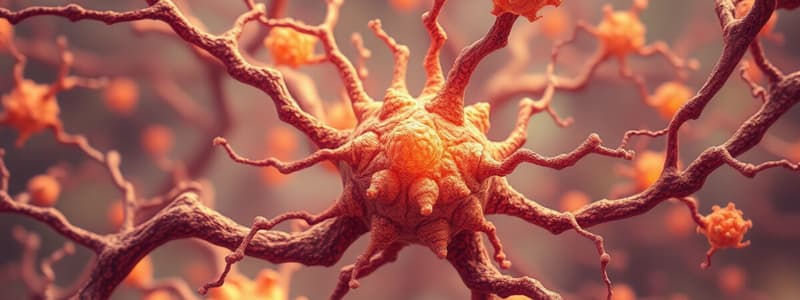Podcast
Questions and Answers
What does LTP primarily achieve in neuronal communication?
What does LTP primarily achieve in neuronal communication?
- Obliterating synaptic pathways
- Weakening of synaptic transmission
- Normalizing neurotransmitter levels
- Strengthening of synaptic transmission (correct)
Which role do second-messenger signaling pathways play in LTP?
Which role do second-messenger signaling pathways play in LTP?
- They have no significant impact on synaptic processes
- They only affect postsynaptic cell sensitivity
- They prevent receptor activation altogether
- They alter neurotransmitter release in the presynaptic cell (correct)
Which factor is NOT essential in distinguishing different types of LTP?
Which factor is NOT essential in distinguishing different types of LTP?
- Type of receptors involved
- Type of ion channels involved
- Mechanism of neurotransmitter synthesis (correct)
- Second-messenger signaling pathways
What is the effect of NMDA receptor antagonists like APV on LTP?
What is the effect of NMDA receptor antagonists like APV on LTP?
What cellular alteration does presynaptic LTP involve?
What cellular alteration does presynaptic LTP involve?
Which of the following is associated with the concept of experience-dependent plasticity within LTP?
Which of the following is associated with the concept of experience-dependent plasticity within LTP?
Which type of AMPARs is directly linked to the mechanisms of LTP?
Which type of AMPARs is directly linked to the mechanisms of LTP?
What is one of the initial triggers in the process of inducing presynaptic LTP?
What is one of the initial triggers in the process of inducing presynaptic LTP?
What is the initial step that leads to increased glutamate release in the process of LTP in the Mossy Fiber?
What is the initial step that leads to increased glutamate release in the process of LTP in the Mossy Fiber?
In classical conditioning, what role does the calcium/calmodulin-dependent adenylyl cyclase play?
In classical conditioning, what role does the calcium/calmodulin-dependent adenylyl cyclase play?
Which factor is responsible for further potentiation of cAMP production following a tail shock in classical conditioning?
Which factor is responsible for further potentiation of cAMP production following a tail shock in classical conditioning?
What is the consequence of RIM1α knockout in relation to Mossy Fiber LTP?
What is the consequence of RIM1α knockout in relation to Mossy Fiber LTP?
What is the role of PKA in the process of LTP following the large Ca2+ influx?
What is the role of PKA in the process of LTP following the large Ca2+ influx?
Which step is NOT involved in the mechanism of LTP triggered by calcium influx?
Which step is NOT involved in the mechanism of LTP triggered by calcium influx?
What effect does increased cAMP production have on the synapse during presynaptic facilitation?
What effect does increased cAMP production have on the synapse during presynaptic facilitation?
What triggers the action potential (AP) in the sensory neuron during the classical conditioning process?
What triggers the action potential (AP) in the sensory neuron during the classical conditioning process?
What is one of the key features of long-term potentiation (LTP) related to memory?
What is one of the key features of long-term potentiation (LTP) related to memory?
Which of the following correctly describes the relationship between conditioned and unconditioned stimuli in the context of LTP?
Which of the following correctly describes the relationship between conditioned and unconditioned stimuli in the context of LTP?
What role do calcium permeable AMPARs play in synaptic plasticity?
What role do calcium permeable AMPARs play in synaptic plasticity?
How do LTD protocols differ from LTP protocols in behavioral responses?
How do LTD protocols differ from LTP protocols in behavioral responses?
In the context of LTP's role in memory, which of the following statements is true?
In the context of LTP's role in memory, which of the following statements is true?
What type of stimuli can optical conditioning involve in the context of LTP?
What type of stimuli can optical conditioning involve in the context of LTP?
Which of the following best defines the purpose of optical CS pairing in the context of LTP?
Which of the following best defines the purpose of optical CS pairing in the context of LTP?
What is the significance of the medial geniculate nucleus in optical CS pairing?
What is the significance of the medial geniculate nucleus in optical CS pairing?
What role does PKMζ play in the maintenance of long-term potentiation (LTP)?
What role does PKMζ play in the maintenance of long-term potentiation (LTP)?
Which process is crucial for the late phase of LTP in the Schaffer collateral pathway?
Which process is crucial for the late phase of LTP in the Schaffer collateral pathway?
What is the significance of PKMζ lacking a regulatory domain?
What is the significance of PKMζ lacking a regulatory domain?
What triggers the increase in translation of PKMζ mRNA in CA1 neurons during LTP?
What triggers the increase in translation of PKMζ mRNA in CA1 neurons during LTP?
Which of the following occurs during early long-term potentiation (LTP)?
Which of the following occurs during early long-term potentiation (LTP)?
How does the influx of Ca2+ contribute to structural changes in the late phase of LTP?
How does the influx of Ca2+ contribute to structural changes in the late phase of LTP?
What is the effect of tetanic stimulation on PKMζ levels?
What is the effect of tetanic stimulation on PKMζ levels?
What is primarily responsible for the formation of new presynaptic release sites in LTP?
What is primarily responsible for the formation of new presynaptic release sites in LTP?
What is the characteristic of GluA2-lacking AMPARs in terms of conductance?
What is the characteristic of GluA2-lacking AMPARs in terms of conductance?
What subunit composition is indicated for AMPARs related to experience-dependent plasticity?
What subunit composition is indicated for AMPARs related to experience-dependent plasticity?
In the context of fear conditioning, what accumulates in the lateral amygdala (LA)?
In the context of fear conditioning, what accumulates in the lateral amygdala (LA)?
What effect does reconsolidation update have on fear memories?
What effect does reconsolidation update have on fear memories?
What is the role of cp-AMPARs in synaptic plasticity?
What is the role of cp-AMPARs in synaptic plasticity?
Which study investigated the effectiveness of reconsolidation update in various species?
Which study investigated the effectiveness of reconsolidation update in various species?
What is the role of PICK1 in the context of cp-AMPAR trafficking during long-term potentiation (LTP)?
What is the role of PICK1 in the context of cp-AMPAR trafficking during long-term potentiation (LTP)?
How is the Rectification Index defined?
How is the Rectification Index defined?
What effect does the S845A mutation have on GluA1 functionality?
What effect does the S845A mutation have on GluA1 functionality?
What feature distinguishes calcium permeable AMPARs from other AMPARs?
What feature distinguishes calcium permeable AMPARs from other AMPARs?
Which of the following is associated with the dephosphorylation of GluA1 at S845?
Which of the following is associated with the dephosphorylation of GluA1 at S845?
What is the proposed effect of activation of protein kinase A (PKA) during LTP on GluA1?
What is the proposed effect of activation of protein kinase A (PKA) during LTP on GluA1?
What role does the subunit composition of AMPARs play in their function?
What role does the subunit composition of AMPARs play in their function?
What is the implication of the accumulation of cp-AMPARs in fear conditioning?
What is the implication of the accumulation of cp-AMPARs in fear conditioning?
What key concept is associated with cp-AMPARs and synaptic plasticity?
What key concept is associated with cp-AMPARs and synaptic plasticity?
Which type of AMPAR is suggested to promote synaptic activity during reconsolidation?
Which type of AMPAR is suggested to promote synaptic activity during reconsolidation?
How does the removal of cp-AMPARs contribute to synaptic dynamics?
How does the removal of cp-AMPARs contribute to synaptic dynamics?
What interaction occurs between GluA2 and PICK1 during LTP?
What interaction occurs between GluA2 and PICK1 during LTP?
Which phosphorylation site on GluA1 is critical for its role in synaptic plasticity?
Which phosphorylation site on GluA1 is critical for its role in synaptic plasticity?
Flashcards
LTP
LTP
Long-term potentiation; a strengthening of synaptic transmission.
Types of LTP
Types of LTP
Different forms of LTP exist, each involving distinct cellular and molecular mechanisms.
AMPAR Trafficking
AMPAR Trafficking
Movement of AMPA receptors, impacting post-synaptic cell sensitivity to neurotransmitters.
Early LTP
Early LTP
Signup and view all the flashcards
Late LTP
Late LTP
Signup and view all the flashcards
Presynaptic LTP
Presynaptic LTP
Signup and view all the flashcards
Mossy Fiber
Mossy Fiber
Signup and view all the flashcards
Tetanus
Tetanus
Signup and view all the flashcards
Large Ca2+ influx
Large Ca2+ influx
Signup and view all the flashcards
Ca2+/calmodulin-dependent Adenylyl Cyclase
Ca2+/calmodulin-dependent Adenylyl Cyclase
Signup and view all the flashcards
PKA Activation
PKA Activation
Signup and view all the flashcards
Increased Glutamate Release
Increased Glutamate Release
Signup and view all the flashcards
Classical Conditioning
Classical Conditioning
Signup and view all the flashcards
Presynaptic Facilitation
Presynaptic Facilitation
Signup and view all the flashcards
Siphon Touch
Siphon Touch
Signup and view all the flashcards
Tail Shock
Tail Shock
Signup and view all the flashcards
Late LTP
Late LTP
Signup and view all the flashcards
Early LTP
Early LTP
Signup and view all the flashcards
PKMζ
PKMζ
Signup and view all the flashcards
AMPA Receptor
AMPA Receptor
Signup and view all the flashcards
LTP Maintenance
LTP Maintenance
Signup and view all the flashcards
Calcium influx
Calcium influx
Signup and view all the flashcards
Structural Changes
Structural Changes
Signup and view all the flashcards
CREB
CREB
Signup and view all the flashcards
LTP and Memory Link
LTP and Memory Link
Signup and view all the flashcards
Optical Conditioning
Optical Conditioning
Signup and view all the flashcards
Conditioned Response
Conditioned Response
Signup and view all the flashcards
Causal Link (LTP & Memory)
Causal Link (LTP & Memory)
Signup and view all the flashcards
Tone/Light CS
Tone/Light CS
Signup and view all the flashcards
Postsynaptic Strengthening
Postsynaptic Strengthening
Signup and view all the flashcards
LTD Protocol
LTD Protocol
Signup and view all the flashcards
Synaptic Transmission Strength
Synaptic Transmission Strength
Signup and view all the flashcards
Calcium Permeable AMPARs (cp-AMPARs)
Calcium Permeable AMPARs (cp-AMPARs)
Signup and view all the flashcards
Experience-Dependent Plasticity
Experience-Dependent Plasticity
Signup and view all the flashcards
Reconsolidation
Reconsolidation
Signup and view all the flashcards
AMPA Receptor Subunits
AMPA Receptor Subunits
Signup and view all the flashcards
GluA2-lacking AMPARs
GluA2-lacking AMPARs
Signup and view all the flashcards
Fear Conditioning
Fear Conditioning
Signup and view all the flashcards
Postsynaptic Plasticity
Postsynaptic Plasticity
Signup and view all the flashcards
Rectification Index
Rectification Index
Signup and view all the flashcards
Synaptic Conductance
Synaptic Conductance
Signup and view all the flashcards
Reconsolidation Update
Reconsolidation Update
Signup and view all the flashcards
cp-AMPARs
cp-AMPARs
Signup and view all the flashcards
PICK1
PICK1
Signup and view all the flashcards
LTP (Long-term Potentiation)
LTP (Long-term Potentiation)
Signup and view all the flashcards
GluA1 S845 phosphorylation
GluA1 S845 phosphorylation
Signup and view all the flashcards
GluA1 S845 Dephosphorylation
GluA1 S845 Dephosphorylation
Signup and view all the flashcards
Reconsolidation Update
Reconsolidation Update
Signup and view all the flashcards
S845A mutation
S845A mutation
Signup and view all the flashcards
LTD (Long-term Depression)
LTD (Long-term Depression)
Signup and view all the flashcards
Synaptic Plasticity
Synaptic Plasticity
Signup and view all the flashcards
Phosphorylation
Phosphorylation
Signup and view all the flashcards
Study Notes
Molecular Basis of Synaptic Plasticity I
- Synaptic plasticity is a biological process where specific patterns of synaptic activity cause changes in synaptic strength.
- This is thought to contribute to learning and memory.
- Both pre-synaptic and post-synaptic mechanisms contribute.
- LTP (long-term potentiation) is a family of processes strengthening synaptic transmission.
- These mechanisms differ based on receptor, ion channel, and second-messenger signaling pathway importance.
- Mechanisms are found both in pre-synaptic (altering release) and post-synaptic (sensitivity to the neurotransmitter) cells.
Lecture Outline
- Synaptic Plasticity
- LTP (Long-Term Potentiation)
- Types of LTP
- AMPAR Trafficking
- Stages of LTP
- Early LTP
- Late LTP
- Molecular Basis of LTD (Long-term Depression)
- LTP/LTD and Memory?
- Experience-Dependent Plasticity
- Calcium Permeable AMPARS
What is Synaptic Plasticity?
- Synaptic plasticity is the biological process by which specific patterns of synaptic activity change synaptic strength. It's thought to be a key process in learning and memory.
Long-Term Potentiation (LTP)
- LTP can last for days to weeks.
- A graph shows the amplitude of population EPSPs (excitatory postsynaptic potentials) changes over time.
- Different pathways show varying magnitudes of the response.
LTP
- LTP is a family of processes that strengthen synaptic transmission.
- These processes differ based on the relative importance of various receptors, channels, and signaling pathways, either in the pre-synaptic cell (altering release) or the post-synaptic (sensitivity to the neurotransmitter) cell.
Presynaptic LTP: Mossy Fiber
- Large Ca2+ influx into the presynaptic terminal.
- Activation of a calcium/calmodulin-dependent adenyl cyclase complex.
- Activation of PKA (protein kinase A).
- Increase in glutamate release.
LTP in the Mossy Fiber: Non-associative
- Large Ca2+ influx into the presynaptic terminal.
- Activation of a calcium/calmodulin-dependent adenyl cyclase complex.
- Activation of PKA.
- Increase in glutamate release.
Classical Conditioning
- Siphon touch triggers action potentials in sensory neurons, causing Ca2+ influx in the pre-synaptic terminal.
- Activation of Ca2+-sensitive adenyl cyclase (AC), which generates cAMP, leading to increased cAMP production.
- Tail shock triggers further potentiation through 5-HT release.
Vesicle Life Cycle: Docking
- RIM binds to Munc13, and Rab3/27 to dock the vesicle, along with N, P, and Q-type Ca2+ channels.
Postsynaptic LTP: Schaeffer Collateral
- Normal synaptic transmission involves glutamate release from the presynaptic terminal, binding to NMDA and AMPA receptors, and subsequent membrane depolarization.
- The induction of LTP involves increased glutamate release and postsynaptic membrane depolarization, and this process involves NMDA receptor activation and Ca2+ influx.
- Retrograde messengers such as NO help enhance glutamate release.
AMPAR Insertion and Silent Synapses
- Alteration in AMPAR number is a crucial mechanism for LTP (Long-Term Potentiation) and LTD (Long-Term Depression).
- Silent synapses are synapses where AMPA receptors are not located on the post-synaptic membrane.
- Pairing stimuli initiates AMPA receptor insertion into post-synaptic membranes.
AMPAR Trafficking
- AMPARs (α-amino-3-hydroxy-5-methyl-4-isoxazolepropionic acid receptor) are mobile in the plasma membrane and in spines.
- Local rises in intracellular calcium decrease GluA2 mobility and accumulate GluA2 in synapses.
- LTD (Long-term depression) involves internalization of AMPARs.
AMPAR trafficking: Lateralization
- AMPARs are mobile in the plasma membrane.
- Local rises in intracellular calcium decrease GluA2 mobility and accumulate GluA2 in synapses.
- LTD (long-term depression) involves internalization.
AMPAR Trafficking: Mechanisms
- Key protein mechanisms regulating AMPAR trafficking include PSD95 and TARPS, NSF and AP2, PICK1 and ABP/GRIP, and SAP97 and Myosin VI.
LTP vs AP2
- The AP2 adapter complex binds to an overlapping region of GluA2.
- NSF probably occupies this area to stabilize the receptors at synapses.
PICK1 vs ABP/GRIP
- PICK1 is involved in recycling AMPARs back to the plasma membrane.
- ABP/GRIP also plays a role in the lateral movement of AMPARs within synapses.
SAP97 and Myosin VI
- Synapse-associated protein 97 (SAP97) binds the GluA1 PDZ domain.
- Myosin VI is a motor protein, and the phosphorylation of SAP97 by CaMKII prompts the movement of GluA1 to synapses.
Early vs Late LTP
- Early-phase LTP (1-3 hours) does not need protein synthesis, while Late-phase LTP (24 hours) does require protein synthesis (including cAMP and PKA activation).
LTP Maintenance: PKMζ
- PKMζ (an isoform of protein kinase C) is constitutively active, maintaining LTP.
- PKMζ enhances the actions of NSF, preventing postsynaptic removal of GluA2.
Molecular basis of LTD
- NMDA-LTD and mGluR5-LTD mechanisms describe different pathways leading to LTD (long-term depression).
- There are protein phosphatase cascades and intracellular calcium changes involved in LTD (long-term depression).
Experience-Dependent Plasticity: Fear
- Pavlovian classical conditioning modifies synaptic transmission.
- Fear conditioning influences thalamic afferent potentiation.
Reconsolidation Update Successfully Erases Fear Memories in Mice, Rats, and Humans
- Extinction-reconsolidation boundaries are key to persistent attenuation of fear memories.
- Preventing fear return through reconsolidation update mechanisms is possible.
- A protocol for updating involves procedures to decrease CR (conditioned response).
Experience-Dependent Plasticity
- Structural and functional changes in neuronal circuits based on experience (response to experience) is the topic.
- A diagram shows the potential differences of neural response in response to environmental stimuli - suggesting modification.
- Some animals demonstrate changes in ocular dominance based on experience.
(cp-AMPARs and Plasticity)
- Increased cp-AMPARs in the lateral amygdala (LA) after fear conditioning.
- Removal of cp-AMPARs contributes to reconsolidation and memory extinction.
- Regulation of cp-AMPAR trafficking, including mechanisms like phosphorylation, recycling and movement.
AMPAR Subunit Composition
- AMPAR subunit composition (GluA1-lacking and AMPAR subunits) matters in postsynaptic plasticity. -Rectification in relation to AMPAR subunit composition.
Studying That Suits You
Use AI to generate personalized quizzes and flashcards to suit your learning preferences.



